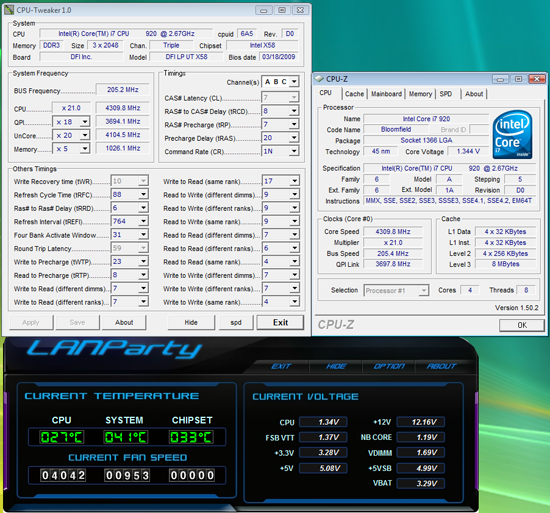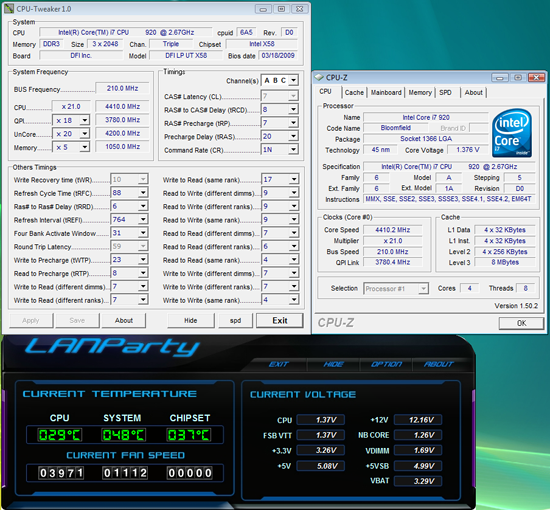Intel Core i7 920 D0 Stepping - Preview
by Gary Key on April 6, 2009 11:30 AM EST- Posted in
- Gary's First Looks
We received our first Core i7 920 D0 stepping from ASRock a few days ago and have been testing it thoroughly on their X58 SuperComputer Motherboard outfitted with four GTX 260-216 video cards. This new stepping certainly shows promise as initial clocking, voltage levels, and memory speeds were improved for the most part over our best C0 stepping. However, the differences were not exciting enough for us to immediately whip out the credit card and go hunt down a D0 stepping processor. In the middle of our testing, ASRock provided an updated BIOS tuned with the D0 stepping in mind and the results changed enough for us to seek a retail processor. Our ES sample was good, not as good as some hand picked samples we noticed at various forums back in March, but we wanted a retail processor.
We called up our good friends at TankGuys and they were able to hook us up (after our credit card cleared) with two D0 stepping 920 processors. Ben was able to overnight the first unit in time for us to test over the weekend and our initial results have just been terrific to date. Unfortunately, our ASRock X58 board (yes, this board makes for a very good multi-GPU platform) was tied up in testing for an upcoming Workstation review. So looking around the lab, we grabbed our trusty DFI LanParty UT X58-T3eH8 and updated it with the latest magical mystical BIOS from Oskar, Jarry, & Company. This particular BIOS is very D0 stepping friendly along with incorporating a few changeable settings like Round Trip Latency (RTL) that allows us to clock our Corsair Dominator GT memory kit a little higher than the other X58 motherboards.
The first test results just blew us away and we wanted to share one particular result today. We are still testing and will have a full article up in the near future featuring a variety of motherboards and cooling choices, but at this moment, the D0 920 stepping provides real and tangible benefits for the overclocking community over the previous C0 steppings. There is no difference in application benchmarks between the two processors at stock or like overclocked settings, nothing drastic has changed like cache levels or the IMC design. Rather this is a "standard continuous process improvement" update as Intel officially informed us. These improvements have enabled us to achieve higher overclocks at like or lower voltages, higher memory speeds at like or lower voltages, and as a result, our CPU, PWM, and case temperatures are down while overclocked numbers are up. Until we finish up our testing, the screenshot below is one example (not even our best) of our test results with the Core i7 920 D0 (3845B027 lot code) processor.

We enabled Turbo mode on all four cores for a final 21x CPU multiplier, set Bclk to 205, memory ratio to 2:10, Core VID at 1.345V, VTT to 1.37V, IOH to 1.19V, and VDimm at 1.69V. This resulted in a final CPU speed of 4.309 GHz, memory speed at 2052 with 7-8-7-20 1T timings, and it is 24/7 stable. We actually could reduce Core VID to 1.30V, VTT to 1.34V, and VDimm to 1.67V and pass our OCCT/Prime 95 tests. However, at the reduced voltage rates our video encoding tests with RipBot264 or HandBrake would fail along with our trusted Crysis WarHead and PCMark Vantage x64 loop testing. We think we can reduce the voltages slightly from their current settings and still pass our benchmark test suite, but for now we feel safe with our results.
The question that has not been answered yet is how our C0 processors steppings faired. First off, none of the C0 steppings we have would operate at these particular voltage settings, in fact two of them failed to POST. Our best C0 sample is requiring 1.425V on Core Vid, 1.250V IOH, 1.475V VTT, and 1.71V VDimm to just make it into Vista Ultimate 64 and we still have not dialed in application stability yet. Once we complete the C0 testing, expect to hear back from us on this new/old processor.

We just passed the eight hour test mark (multi-tasking tests, OCCT, PCMark Vantage x64 loops) with the above setup. Once again, we set our CPU multiplier to 21x for all cores, Bclk at 210, 2:10 memory ratio, and voltages set to 1.376V on Core Vid, 1.37V VTT, 1.26V IOH, along with 1.69V on VDimm. This results in a 4.41GHz clock speed and DDR3-2100 memory speed at 7-8-7-20 1T timings.
We will be back shortly with results on the ASRock X58 SuperComputer board with a new performance level BIOS as our workstation testing with it is now complete.
















51 Comments
View All Comments
aigomorla - Monday, April 6, 2009 - link
Just like to say i told you guys so.D0 - HOT and FTW!!!!
But i showed you guys this last week in the forums with my 975 D0. :P
DigitalFreak - Monday, April 6, 2009 - link
What, you want a cookie or something?aigomorla - Monday, April 6, 2009 - link
Need to add one more comment.These Chips DO NOT RUN COOLER.
If they do its because of the lower voltage requirement for a stable overclock.
But push the voltage and overclock the same on both C0/C1 vs a D0, you'll run near the same heat.
i7 is NOT a cool chip when overclocked.
7Enigma - Wednesday, April 8, 2009 - link
Statement #1: These Chips DO NOT RUN COOLER.Statement #2 (immediately after statement #1): If they do its because of the lower voltage requirement for a stable overclock.
Well which one is it? :) You kind of destroyed your own argument in 2 sentences. Of course if you run the same voltage at the same clock speed through C/D they will produce the same amount of heat. That's basic science. They run cooler because you can run the same clock speed at LOWER voltages on the D0 chip, which in this case (but not always) allows for a higher maximum overclock on average.
Now this was an N=2, which really isn't statistically significant, but I think the general trend is sound...
taltamir - Monday, April 6, 2009 - link
"The question that has not been answered yet is how our C0 processors steppings faired"Should say FARED not FAIRED.
tshen83 - Monday, April 6, 2009 - link
It is a known overclocker's secret that Xeons mostly overclock better than the equivalent consumer counter parts.All Xeons are D0 spec already. Just go to Intel sSpec finder page. All Xeon 3500s and Xeon 5500s are stepping D0.
The interesting combination is the Asus Z8NA-D6C board with 2 Xeon E5504 D0 2Ghz, giving you SMP 8 real Nehalem cores(HyperThreading disabled, but that's good for overclocking), and see if you can overclock those into SMP 4Ghz+ :)
Rajinder Gill - Monday, April 6, 2009 - link
The 95w Xeons look tasty, but also are expensive. Secondly, you get the additional QPi link, so it's unknown how they'll fare in host clock abilities (ultimately QPI speed). IF that rules out high BCLk ability you're relegated to the big leagues. You'll want one which at least comes in over 2.6GHz I think, which at current pricing puts it in the $1100 category. The X5570 looks creamy at $1700. I'd love to test the higher multiplier Xeon's out for overclocking.The 920's are still specced at 130w TDP or so, so not in the league of the 95w Xeons - but a lot cheaper for a punt.
regards
Raja
tshen83 - Monday, April 6, 2009 - link
Well, the point is, get a Xeon equivalent.Xeon W3520 is the i7-920 equivalent. And it will definitely overclock better, supports ECC ram, and supports more datacenter features.
X5570 is a pretty good processor, but it is really designed to challenge 4S AMD and 4S Dunnington in DB applications where they load up to 144GB of ram in a system. If you compare the X5570 to Xeon X7460s, or Opteron 8384s then it is cheap.
The point isn't the highest end. The highest end parts is simply technological demonstrations, proving that Intel's manufacturing is capable of doing the clock speed. The real juice is the lowest end parts such as the E5504s selling for as little as $227. I bet you even the E5504s at 2.0Ghz can be as good as AMD's Opteron 2384s at 2.7Ghz which is priced at 700 dollars+ compared to Intel's bargain basement pricing. AMD would have no choice but to cut the price of their entire Opteron line, especially the top end ones if they aren't even as fast as the E5504s. The current pricing structure from AMD isn't competitive.
If 2 Intel's X5570 at 2.93Ghz($1700 each) can perform the same as 4 Opteron 8384s(1900 each), don't you see the need for AMD to cut price by 50% across the entire line? Performance per Mhz, per watt or per dollar is so screwed up for AMD, it is not even funny any more.
Rajinder Gill - Monday, April 6, 2009 - link
I'd actually overlooked those. So long as the memory multi's can be fully unlocked as they are with the 920 it would be a cool option.tshen83 - Monday, April 6, 2009 - link
I do know what I am talking about :)http://www.spec.org/cpu2006/results/res2009q1/cpu2...">http://www.spec.org/cpu2006/results/res2009q1/cpu2...
http://www.spec.org/cpu2006/results/res2009q1/cpu2...">http://www.spec.org/cpu2006/results/res2009q1/cpu2...
Whatever conclusion you can draw from the two links I just posted, just keep it to yourself. If you have the intelligence to understand those links, you would know why AMD is so screwed.